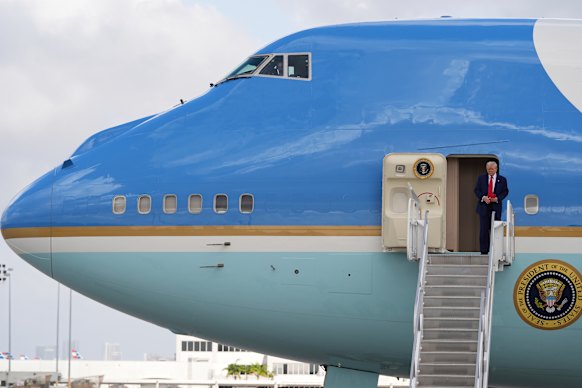Donald Trump administration classifies cost of upgrading ‘free’ 747-8 from Qatar

“I would never be one to turn down that kind of an offer,” the president said in May. “I mean, I could be a stupid person and say, ‘No, we don’t want a free, very expensive aeroplane.’”
It is free in the sense that a used car handed over by a neighbour looking to get it out of his driveway is free. In this case, among the many modifications will be hardened communications, anti-missile systems and engine capabilities to take the president quickly to safety as one of the older Air Force Ones did on September 11, 2001, when al-Qaeda attacked the United States. And there is the delicate matter of ridding the jet of any hidden electronic listening devices that US officials suspect may be embedded in the walls.

One careful owner: Qatar’s surplus 747-8 has been on the market for about five years.
Then, of course, it has to be stuffed with the luxuries – and gold trim – with which the 47th president surrounds himself, whether he is in the Oval Office or the air. The jet’s upper deck has a lounge and a communications centre, while the main bedroom can be converted into a flying sick bay in a medical emergency.
So it’s no surprise that one of Washington’s biggest guessing games these days is assessing just where the price tag will end up, on top of the $US4 billion already being spent on the wildly behind-schedule presidential planes that Boeing was supposed to deliver last year. It was those delays that led Trump to look for a gift.
Air force officials privately concede that they are paying for renovations of the Qatari Air Force One with the transfer from another massively overbudget, behind-schedule program, called the Sentinel. That is named for the missile at the heart of Washington’s long-running effort to rebuild America’s ageing, leaky, ground-launched nuclear missile system.
Loading
The project was first sold to Congress as a $US77.7 billion program to replace all 400 Minuteman III missiles, complete with launch facilities and communications built to withstand both nuclear and cyberattack. By the time Trump returned to office, that figure had ballooned by 81 per cent, to $US140 billion and climbing, all to reconstruct what nuclear strategists agree is the most vulnerable, impossible-to-hide element of America’s nuclear deterrent.
And that was the number before the air force announced a few months ago that it would have to dig all-new silos across Montana, Wyoming and North Dakota because the old Minuteman silos were leaking and crumbling.
The first of the Minutemen was installed 55 years ago, when Richard Nixon was president and Leonid Brezhnev was inside the Kremlin. Washington and Moscow had a combined total of more than 30,000 nuclear weapons pointed at each other. (Today it is closer to 3100.)
The good news is that in the first Trump administration, the air force got rid of the command-and-control systems that still used eight-inch floppy disks, proving that the so-called deep state can get something done when it digs, well, deep.
Some nuclear strategists argue that ground-based nuclear weapons do not need to be replaced at all; they are far more vulnerable than weapons travelling under the sea on stealthy submarines or that can be loaded on bombers. But the Pentagon doesn’t want to part with one-third of the nuclear “triad”, and the silos and their command posts are big employers in the rural west.

The current Air Force One is a Boeing VC-25, the military version of the hugely successful 747. Credit: AP
They serve another function in the second Trump administration. The modernisation program has proved to be the perfect thing if you were determined to hide how much you were spending on a plane, especially one equipped to order up a nuclear strike if needed.
In testimony before Congress in June, Troy Meink, the air force secretary, said he thought the cost of the Air Force One renovations would be manageable.
“I think there has been a number thrown around on the order of $US1 billion,” he said. “But a lot of those costs associated with that are costs that we would have experienced anyway; we will just experience them early [before Boeing delivers its two Air Force Ones]. So it wouldn’t be anywhere near that.
“We believe the actual retrofit of that aircraft is probably less than $US400 million.”
If so, that would be a bargain. But engineers and air force experts who have been through similar projects have their doubts that it can be accomplished for anything like that price. Members of Congress express concern that Trump will pressure the air force to do the work so fast that sufficient security measures are not built into the plane. When asked last week, the Air Force said it simply could not discuss the cost – or anything else about the plane – because it is classified.
(For collectors of such bureaucratic evasions, yes, the air force is willing to discuss the cost of building a new generation of intercontinental ballistic missiles, but not the cost of renovating the president’s aircraft.)
Loading
Only at the Pentagon could someone reprogram $US934 million and expect no one to notice. The coffers were refilled with the passage of the budget reconciliation bill several weeks ago, budget officials say.
“The more we learn about this deal, the more disturbing it becomes,” said Democratic senator Jeanne Shaheen, who serves on the armed services committee. “The security implications of accepting a private plane from a foreign nation as Air Force One and the resulting ethical concerns a gift of that size creates were already significant.”
But it was more worrisome, Shaheen said, that “this administration is diverting funds from the nuclear modernisation budget to finance costly renovations to this plane”.
In doing so, she said, “we’re weakening our credibility to fund a vanity project for President Trump”.



